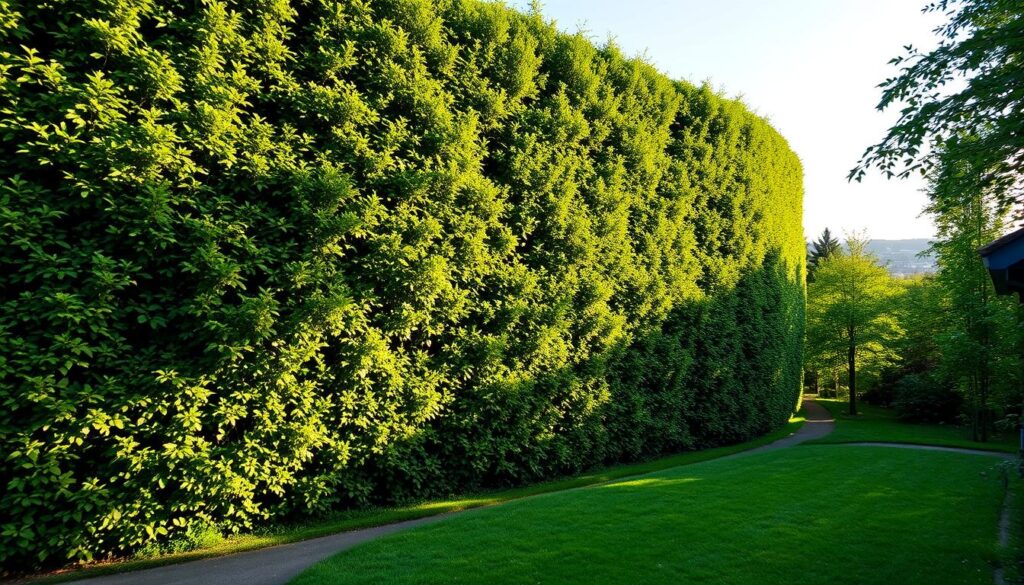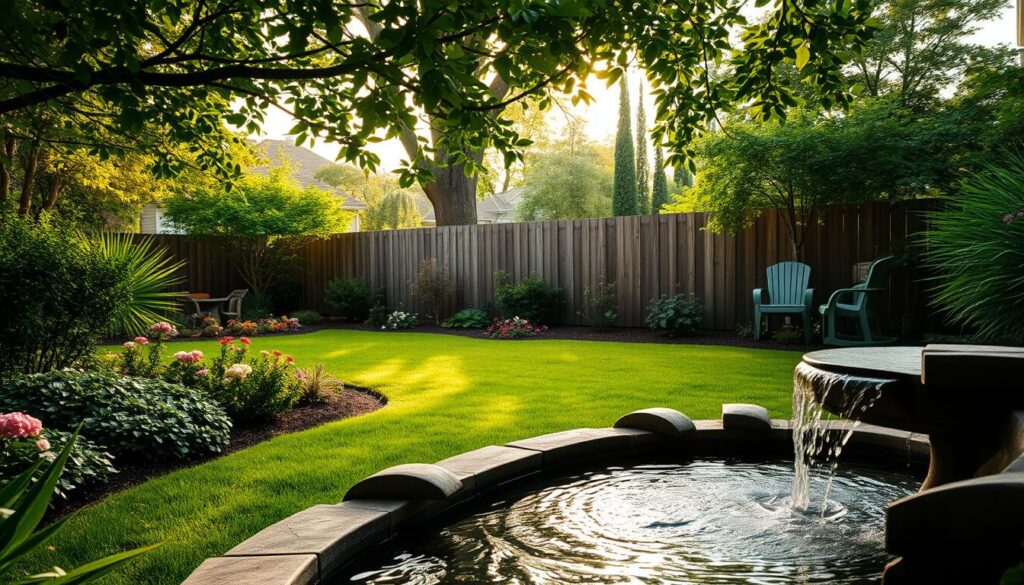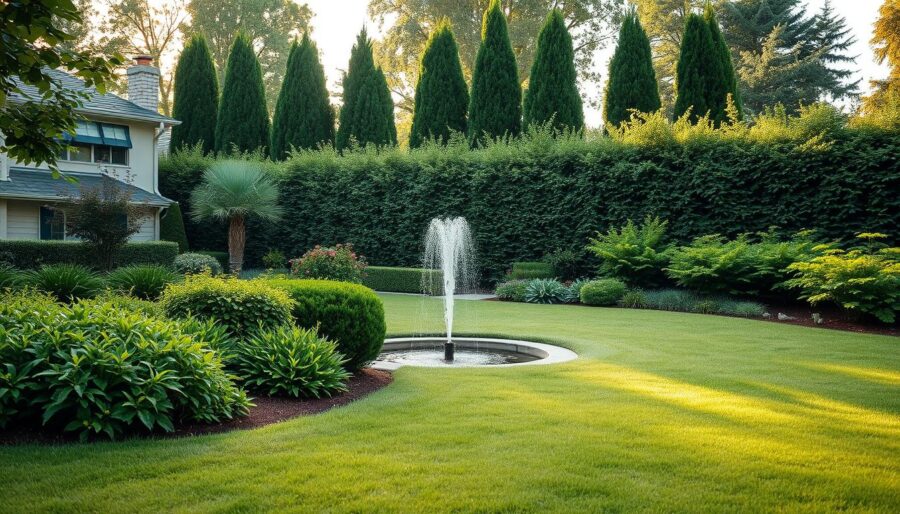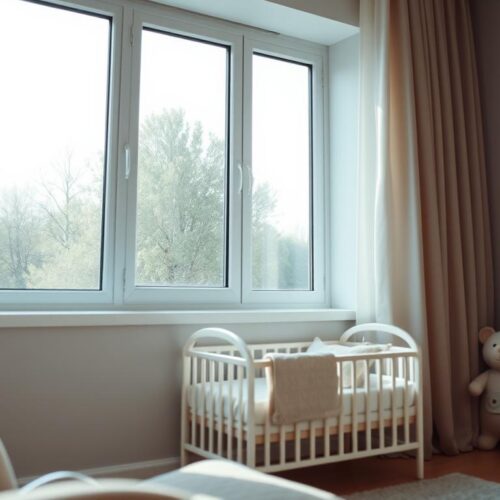In our fast-paced world, outdoor noise is a big problem. It messes with our peace. But, landscaping can help us fight this noise. With the right design, your backyard can become a quiet escape. Planting certain trees and bushes works well.
Building barriers is another smart move. This idea, called acoustic landscaping, can really change how your outdoor space feels. It makes your home a more peaceful place.
Understanding Outdoor Noise Pollution
Outdoor noise pollution is a big problem in cities and suburbs. Traffic, construction, and parties are major sources. These add up to create a noisy, stressful environment.
Studies show that loud noise can increase stress levels in your body. This stress can mess with your sleep and harm both your mental and physical health. Knowing this, finding ways to reduce noise in your area is key.
It’s crucial to know what’s causing noise pollution outside. Once you understand this, you can find ways to lessen the noise. This improves your life’s quality.
The Benefits of Reducing Noise with Landscaping
Landscaping is key to a calm environment, boosting your well-being. Reducing noise through smart landscaping can make your space better. By using trees, shrubs, and nature, you can block outside noise. This makes your outdoor area peaceful and relaxing.
Noise pollution can cause stress and health problems. Landscaping offers a solution, turning your yard into a quiet haven. You’ll enjoy your outdoor space more, for relaxation or fun times with family. It’s a great way to chill after a busy day.
Landscaping uses nature to make places more peaceful. It shows how thoughtful design can lead to a healthier mind and body. As you look into landscaping, think about how different parts can lower noise. This improves your home’s environment.
Acoustic Landscaping for Homes
Acoustic landscaping makes outdoor areas quiet and beautiful. It helps control noise by using trees, shrubs, and plants. This not only cuts down on noise but also makes your yard look great.
To make sure your landscape can absorb sound, choose plants carefully. Trees with lots of leaves, especially evergreens, are good for blocking noise all year. Add different kinds of trees, shrubs, and ground covers for the best effect.
Think about where to place each plant in your yard. The right spots can help them block more noise. Try to arrange your plants in layers. Tall trees go in the back, then medium shrubs, with low plants in front. This setup is not only good looking but also helps reduce noise.
Evergreen Trees as Natural Sound Barriers
Evergreen trees are great for blocking noise because they keep their leaves all year. They make your yard look good and help quiet down noise. The way their leaves, branches, and bark are built helps soak up sound. This makes them perfect for places with a lot of noise.
Some top trees for blocking noise are the Eastern White Pine, Leyland Cypress, and Norway Spruce. Each kind has its own benefits for different places. For example, Eastern White Pine gets big and forms a thick green wall. Leyland Cypress grows fast in many soils. Knowing how these trees grow helps you decide where to put them.
To block noise better, plant these trees near busy roads or factories. Putting them in staggered rows makes them even better at stopping noise. Adding evergreens to your yard doesn’t just make it prettier. It also makes it quieter and more peaceful.
Choosing the Right Shrubs for Noise Reduction
Choosing the right shrubs is key for cutting down on noise. Some plants are great at blocking outdoor noise pollution. They make your garden look good and help keep it quiet.
Go for hardy native shrubs for less upkeep and better sound blocking. Top picks include:
- Boxwood – It’s thick and bushy, great for hiding things.
- Holly – Its heavy leaves help quiet sounds.
- Juniper – Beautiful and effective for noise control.
- Mountain Laurel – Tough, with lots of green leaves.
Plan your garden with noise reduction in mind. Putting shrubs together makes them work better at stopping noise. This setup turns your garden into a quiet, nice-looking spot.
Using Tall Hedges for Effective Sound Control
Tall hedges are great for reducing noise and increasing privacy outside. They block sound waves and make your yard look better. By planting them in the right places, tall hedges can keep out a lot of unwanted noise.
It’s important to choose the right kind of plants for a sound barrier. Plants like Leyland cypress, green giant arborvitae, and boxwood are best. They grow quickly, are tall, and keep their leaves all year. This means they provide privacy and noise control no matter the season.
Think about where to place your hedges to block noise best. Putting them close to where the noise comes from, like roads, helps a lot. Making sure they’re planted deep enough also helps them absorb more sound.
Keeping your hedges healthy is key to them blocking noise well. Trimming them often helps them grow thick and stay at the right height. Making sure they get enough water and food helps them grow strong and tall. This makes them better at stopping noise.
| Species | Height | Growth Rate | Notes |
|---|---|---|---|
| Leyland Cypress | 30-40 ft | Fast | Dense foliage, ideal for privacy |
| Green Giant Arborvitae | 50-60 ft | Medium to Fast | Resilient, excellent for sound control |
| Boxwood | 4-15 ft | Slow to Medium | Great for structured hedges, dense and evergreen |

How Fences Can Help Mitigate Noise Pollution
Fences are great for lowering outdoor noise. They can help block out sounds from cars, neighbors, and other loud noises. By choosing the right materials, you can really cut down on unwanted noise.
Looking for the best fence to block sound? Here’s what to consider:
- Solid Cedar: It’s strong and can block noise thanks to its dense makeup.
- Concrete: Great for busy areas, concrete fences block noise very well.
- Masonry: Like concrete, masonry also blocks noise and looks good in your yard.
The key to a quieter yard lies in the material’s thickness and density. The denser a material, the better it blocks sound. Getting a fence that reduces noise can make your outdoor area more peaceful and improve your home’s look.
Utilizing Earth Berms in Your Landscape Design
Adding earth berms to your landscape design can help block out noise. These soil mounds are not just pretty, they absorb and deflect sound too. To build one, you need to plan carefully. This means figuring out where it should go, how big it should be, and its shape to cut down on noise.
When making a berm, think about its height and width. It should be tall enough to block noise but also wide enough to stay put. Planting things like trees and bushes on your berm helps soak up even more sound. This makes it even better at keeping your space quiet.
Earth berms look better than regular sound walls and fit right in with your garden. They’re also cheaper because they don’t need complicated structures. This makes them a good choice if you want to save some money.
Remember to check if you have enough space for your berm. It needs to be big enough for its height and width so it works right. Adding a berm to your yard can make it look nice and quiet. It’s a way to enjoy your outdoor area more.
Incorporating Water Features for White Noise
Fountains and ponds bring your yard to life while reducing noise. They use white noise to drown out unwanted sounds like traffic. This makes your outdoor space more peaceful.
Here are some water feature options:
- Fountains: They offer visual appeal and spread sound around.
- Ponds: Add small waterfalls to these for extra sound layers.
- Birdbaths: These provide gentle sounds that help you relax.
Keeping water features clean is key. A clean feature looks better and sounds clearer. Make sure to remove leaves and debris, and think about adding plants for more sound.
Adding water features does more than make your yard look good. They help make your outdoor area a calm space. By choosing the right spot for your water features, you turn your garden into a soothing escape.
Effective Noise Reduction Techniques with Plants
Using plants in your outdoor area can help lower noise. Trees and shrubs have special features that help absorb sound. By picking the right kinds and arranging them well, you can make outside sounds nicer and create a peaceful place.
Dense foliage is key for reducing noise. More leaves and branches mean better noise absorption. You might want to pick types like:
- Laurel trees
- Norway spruce
- Boxwood shrubs
Where you put plants matters a lot for cutting down on noise. Put plants close to noise sources like roads or playgrounds to block the sound. Adding more layers of plants makes them even better at stopping noise.
Here’s a table that shows some good plants for noise control and what they’re like:
| Plant Type | Height | Sound Absorption | Ideal Location |
|---|---|---|---|
| Laurel | 6-12 feet | High | Sunny to partially shaded |
| Norway Spruce | 40-60 feet | Medium-High | Full sun |
| Boxwood | 3-15 feet | Medium | Sunny to partially shaded |
Knowing about these plants and how to use them can make your outdoor area quieter and more enjoyable.
Sound Absorption Products for Outdoor Spaces
Adding sound absorption products outdoors makes it more soundproof. You can find materials and panels made for outside use that lower noise pollution. These sound control methods are great for looks and for making your outdoors quiet.
Here’s what to look for in sound absorption products:
- Acoustic Panels: You can get these in many designs. They fit into fences or walls, matching your garden perfectly.
- Sound Barriers: These barriers, built from special materials, soak up sound well. They also stand strong against outside noises.
- Noise-Reducing Mats: Placing these mats in areas where people hang out or walk will cut down on noise.
- Softscape Solutions: Adding fuller bushes and decorative grass with these products can make them work better.
For installing sound absorption products, remember these tips:
- Look around your area to find where noises are coming from, like traffic or construction.
- Pick products that look good with your garden’s style.
- Think about the size and where to place these products so they work best.
- Keeping up with maintenance means they’ll keep working well.
With the right sound absorption products, your outdoor space will become a calm retreat. Enjoy the beauty of nature without loud noises ruining it.
| Product Type | Function | Installation Tips |
|---|---|---|
| Acoustic Panels | Reduce sound reflection and absorption of noise | Install on fences or walls for best effect |
| Sound Barriers | Create a physical barrier against noise | Position at a distance from noise sources for optimal results |
| Noise-Reducing Mats | Dampen noise from foot traffic | Place in high traffic areas for increased effectiveness |
Creating a Pleasant Backyard Soundscape
Turning your backyard into a soothing soundscape can make being outside much more enjoyable. It creates a welcoming vibe and deals with noise issues at the same time. By carefully choosing different elements, you can cover up loud sounds and make your yard a tranquil space.
Here are some great ideas to make your backyard sound better:
- Wind Chimes: They offer soft, calming tunes that help lessen outdoor noise.
- Bird Feeders: They attract birds whose chirping adds a lovely soundtrack to your garden.
- Outdoor Sound Systems: Playing gentle music or sounds of nature can hide annoying noises, making you feel more at peace.
Adding water features, like fountains, brings peaceful sounds that improve your backyard’s soundscape. Planting thick bushes or flowering plants also blocks out unwanted noise. Together, these smart design moves make your outdoor area a peaceful retreat and better at managing sounds. Your backyard turns into a treasured escape.

The Role of Professional Landscape Designers
Hiring professional landscape designers helps a lot in acoustic landscaping. They know a lot about creating sound barriers that look good with your home and garden. They pick the best plants and materials to lessen noise by using their design knowledge and understanding of local plants.
When you get expert landscaping help, they focus on what your home needs. They look at your yard’s noise problems and find solutions that match how you live. They think about where to place plants, what materials to use for sound barriers, and how to make everything look great.
Getting help from professionals not only makes your yard quieter but also increases your home’s value. They make sure your garden looks good and serves its purpose of reducing noise. This creates a peaceful and beautiful outdoor area you’ll enjoy for a long time.
Challenges of Acoustic Landscaping
Trying to reduce noise through acoustic landscaping can be tough. You might run into issues with challenges of landscaping due to the kinds of plants you pick, where you’re placing them, and other environmental factors.
In cities, finding enough room for landscaping is hard. Small spaces on urban properties can make it tricky to block out sounds. This lack of space means coming up with noise reduction obstacles, calling for inventive strategies to keep the noise away.
Another issue is how fast the plants grow. Picking plants that take a while to get tall enough to block sound can delay results. It’s important to think about what to do until the plants are big enough.
Living close to busy roads or business areas can up the landscaping difficulties. It might be harder to block out the noise if you’re that close to it. Sometimes, natural barriers don’t do much against non-stop loud sounds.
Getting the most out of natural barriers also has its challenges. You have to take care of the soil, deal with weather changes, and keep up with maintenance. All this work helps keep the plants healthy and effective at blocking noises.
Sound Walls vs. Natural Barriers
Choosing between sound walls and trees for noise control? Sound walls are built for the job and work quickly. They bounce sound away from your home, making outdoors more peaceful.
Trees and shrubs, on the other hand, are a natural way to reduce noise. They absorb sound and make your yard look better. Yet, how well they work depends on their type and age.
Deciding comes down to what you need more. If you need quick silence, sound walls are best. If you prefer something pretty that also helps the planet, go for plants. Using both could get you the best of both worlds.
| Criteria | Sound Walls | Natural Barriers |
|---|---|---|
| Noise Reduction | High immediate impact | Variable, depends on plant density |
| Aesthetic Appeal | Industrial look | Natural beauty |
| Maintenance | Low once installed | Requires regular upkeep |
| Cost | High initial investment | Varies with plant selection |
The Importance of Tree Placement in Noise Reduction
Choosing the right spot for trees is key to lowering noise outdoors. Studies show trees are most effective when close to the noise source. They should be put where they can block or soak up sound, making outside areas quieter.
Having lots of plants doesn’t just look good but also quiets things down. The more leaves there are, the more noise they can take in. By placing trees wisely, you make your outdoor area much quieter.
| Tree Type | Sound Absorption Rating | Ideal Placement Distance from Noise Source |
|---|---|---|
| Evergreen Trees | High | 10-15 feet |
| Deciduous Trees | Medium | 15-20 feet |
| Shrubs | Medium to High | 5-10 feet |
When designing your yard, remember different plants block noise in unique ways. Knowing each plant’s sound-stopping power helps you create a calm space. Focusing on where to place your trees can make your garden much more peaceful.
Strategies for Maintaining Your Noise-Reducing Landscape
Keeping your noise-reducing landscape well-maintained is key for it to work well over time. Regular landscaping maintenance ensures plants are healthy and thick. This thickness helps them soak up sound. Here are key ways to make your outdoor area stay lively:
- Regular Pruning: Trimming plants that have grown too much keeps them healthy and promotes new growth. This makes sound absorption better and keeps your yard looking great.
- Consistent Watering: It’s crucial to give your plants enough water. Setting a watering schedule helps them get the moisture they need, especially when it’s dry.
- Mulching: Mulch stops weeds and keeps soil moist. It improves your garden care and makes your landscape prettier.
- Monitoring for Pests: Watch out for bugs that can harm your plants. Use safe pest control to keep your garden healthy without harmful chemicals.
- Maintenance of Water Features: Take care of any water features by cleaning them often. A clean water feature adds calming sounds, helping your noise-lowering efforts.
By adding these steps to your regular care, you’ll keep a lively landscape. It will be beautiful and quiet down noise. With some work, you can have a calm outdoor space to enjoy for many years.
Conclusion
Adding landscaping to fight noise in your yard is key to a calm space. By adding evergreen trees, putting shrubs in the right spots, and using water features, you can cut down on noise. These steps make your yard quieter and also make it look better.
Creating a peaceful outdoor area takes careful planning and action. Everything in your yard can help make it a quiet place for rest and fun times with friends. Think about how plants and buildings can together make a peaceful outdoor hideaway.
When picking landscaping, remember that the right choices can make your life better. Choosing nature-based designs to reduce noise leads to a calm and quiet home. This approach brings peace and quiet to your living space.




